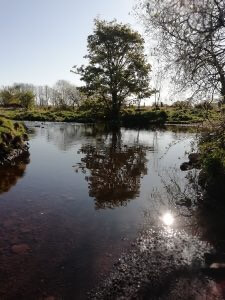
I have to start by saying how much I’m missing people…everyone… and especially my Capital Theatres family and participants from our dementia friendly programme. I really struggle hearing about the difficult and tense times many of our participants are going through and not feeling like I can help in any way. However, this strange period in all our lives has also given me the opportunity to really focus on what people are saying to me and what we as a theatre can offer to make life that little more bearable. A positive is that I am really starting to engage in a way that I just hadn’t considered before with our dementia friendly community.
Last year I had the privilege of meeting lovely Ron Coleman and his partner at our monthly drop-in café. At that time Ron was still developing his theatre performance about Alexa and how it was helping him to manage his dementia diagnosis. I was fascinated and fleetingly considered what else could be achieved through technology…and now here we are having no option but to fully embrace the digital world no matter our age or standing in life. This time has really given me a push to think outside the box and reinvent how we are delivering our creative work at Capital Theatres now. From a place were I never considered a real need for digital delivery, I am now quite sure that the use of digital technology must always run alongside our in-house activity and be a part in our arts programme whether that’s potentially live streams or pre-recorded material.
Of course, in my mind, nothing will ever beat that feeling of coming into a packed theatre, the sights, smells and anticipation in the air but since taking some of our activities online and tweaking them a little to suit digital platforms, it has become glaringly obvious to me that a permanent digital offer is crucial for many people who for whatever reason are feeling isolated at home or don’t have the capacity to come to a venue to take part. It gives a vital opportunity to meet and connect with others and be part of a creative community, albeit virtually. Recorded sessions that are available at a time that is convenient will be a great addition for loved ones and carers of people living with dementia. It removes some of the anxiety and guilt of not turning up on time or at all and allows them to take part at a time that suits them without feelings of rushing. However, I do need to keep in mind, that there are many families who don’t have access to the digital world or a will to use it, and that’s fine too. It’s important that they are not forgotten as we travel down this road. At this time, I have tried to combat this by offering DVD formats of any of the online content we are producing and I am thinking of other opportunities to connect that don’t rely on ‘logging on’, such as audio options and being mindful of increasing access further through subtitles and signed performances. as standard. It’s certainly a steep learning curve and a big challenge in a reduced capacity and ever-changing environment.
Another wonderful outcome through being able to have a digital offer is that our programme has really grown lately with lots of new people being able to join in. It can be frustrating for me and our participants when they can’t book into our sold-out events. In the past, due to staffing and venue capacity I can’t create extra spaces but being able to have pre-recorded performances to share online or with DVDs has really allowed me to connect with people and settings who wouldn’t, couldn’t or kept missing out on tickets! We have been given an opportunity share our tea parties with people in rural Highlands to care settings in England. As mentioned before I had considered how we can perhaps start to live stream some of our most popular events such as our dementia friendly tea parties, now I’m convinced it should be a part of a regular programme. It would give an opportunity for larger care homes without staffing capacity to take groups out to still take part in the wonderful live music or for those who miss out on a ticket to still take part at home with their own afternoon tea!
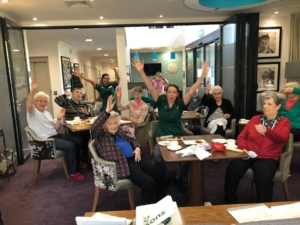
When we closed our venue doors towards the end of March, I’m not going to lie I went into a very overwhelmed state of not knowing what to do, if our programme had any relevance at this time, whether people just found my being in contact a nuisance,…but as I should have expected, as it’s always the way with our wonderful community, by talking and listening to our participants it quickly became clear that our dementia friendly work had to keep going and find new ways for people to keep connecting. It was from feedback that I realised, start with what we do well already and think about what small changes can we make to continue. I didn’t need to be thinking about ground-breaking projects but just keeping people supported, connected and feeling part of something bigger through these darker weeks. I’ve said it many times but the very essence of why our programme at Capital Theatre has continued to flourish is our wonderful focus group of persons living with dementia, our volunteers, wider participants and staff. All I need to is listen to them and the rest falls into place!
We have worked hard over the last 3 months to create “Raise The Curtain” – our digital programme at Capital Theatres whilst our venues are closed. Our dementia arts programme now includes twice monthly drop-in chat sessions with guests popping in from other organisations, contact less afternoon tea deliveries with pre-recorded performances uploaded on You Tube in time for folks to sit down, relax and enjoy a variety of music. We are also sending ‘Joy To The Moment’ short films in collaboration with professional artists and the general public to care settings and day services by DVD to allow them to be shared as many times as required for socially distanced groups or those who are confined to staying their own rooms. Our popular Tea & Jam session was the first activity to go online and with nearly 50 participants it was the session that cemented that there was most definitely a need for people to continue engaging and thriving through arts. All of this has an aim of just taking a little bit of stress and strain away from an afternoon by providing some fun and laughter in the moment together with good cakes and cracking entertainment!

As the weeks go by, it is clear that it could be a while before many of our more vulnerable participants may feel confident to come back into a large gathering at our theatres so we have plans to continue online with our programme and to consider a blended way of slowly being able to provide our live performance and take part opportunities. Our Autumn programme will see opportunities to partner dance together with live and pre-recorded tuition and a live afternoon dance with a performance by World champion dancers. We have a series of early evening ‘Sundown Stories’ online, and in DVD and audio format and a creative writing project for people living with dementia. Lots to keep us going until we can once again be together in the theatre.
Feedback from the sessions has been really fantastic and with lots of people offering their views which is great as it allows us to keep thinking about how we can really make this digital offering work and how to get it out there to the most people.
So for me, so far I’ve had an opportunity to really challenge myself to think creatively about how to continue connecting with the wonderful community of persons living with dementia at Capital Theatres whom I’ve become so very fond of and miss each day. I’m really starting to think outside the box about ways to offer people opportunities to take part and continue to create and enjoy the arts. So for that, and that alone…Covid 19, I thank you!
This digital way of working still wouldn’t be my first choice, as I’ve said nothing beats the thrill of live performance and I’ve had to quickly skill up on using technology with a bit more know-how and not my usual attitude of ‘we’ll just see what happens when I press this!”
Every so often my little inside voice has the personal struggle and panic that what we do isn’t “essential” and not a “priority” but I realise that goes against the very belief I hold true about the profound impact the arts can have on health and well-being of everybody including persons living with dementia. I see it every day; from the person I’m told probably won’t engage with me who when I find just the right song can sing it to from beginning to end. From the sister who says, “I can’t believe he just got up to dance jive with you, I’ve never seen him dance” to the daughter who cries as she sits in the audience watching her often disengaged and agitated father who is playing his long forgotten harmonica and delivering a piece of theatre that he has been a part of creating. Then I remember that the arts has a huge part to play in helping us all to continue flourishing through life and I’m driven to find ways to get through these strange times the only way I know how, by sharing my love of theatre with everyone.
(Photos supplied by Dawn Irvine with permission to share on “bold” social media accounts)



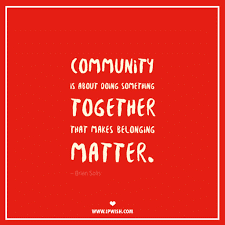 I’m fortunate to have two part time jobs. I work as a research assistant at the University of Edinburgh with “bold” (Bringing out Leaders in Dementia) project and, I am also the family and community development worker with my local Church of Scotland.
I’m fortunate to have two part time jobs. I work as a research assistant at the University of Edinburgh with “bold” (Bringing out Leaders in Dementia) project and, I am also the family and community development worker with my local Church of Scotland.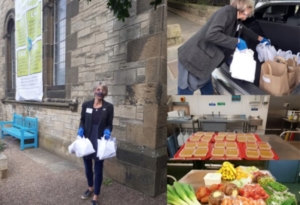

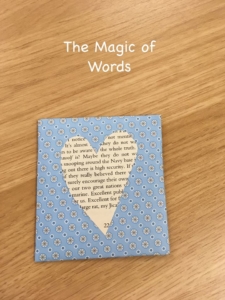

 “I live on Leith Walk in the centre of Edinburgh. In spite of the current social distancing measures, it can be quite busy on the Walk, with people out shopping and having to form orderly queues on the pavements before being permitted inside the supermarkets. Naturally, people are also out for exercise hikes, runs and cycles and taking their dogs out for a walk. One thing I have noticed over the past few weeks is that, as well as physically distancing, people seem to have stopped looking at each other and have started shunning eye contact altogether. It appears that by trying to stay safe and avoid ‘the virus’, many of us are carefully manoeuvring our individual paths away from any sort of eye contact. I was thinking about this while on my daily exercise walk the other morning. Although I live with my husband and son, I was craving human contact outside our little family. I was watching people walking past me, mostly with eyes pinned to the ground, not only circumventing me physically, but also within their regard. The avoidance and lack of acknowledgment made me not only feel a little lonely, but also strangely ‘other’ and apart. I was wondering what would happen if I would actively look for eye contact with passer-byes and purposefully try to make connections. When I facilitate creative workshops, I often use an icebreaker that focuses on eye contact and human connection. First, I ask people to move around the workshop space, noticing their surroundings, but avoiding any eye contact with the other participants. Step 2 asks everybody to take only a fleeting glance into the eyes of a person walking past, before looking away again. Step 3 encourages to hold eye contact a little longer and add a tiny smile. Step 4 asks everyone not only to make eye contact, but to stop and make a physical connection by shaking hands. Until now, no words have been exchanged. By this stage I can usually sense everyone’s eagerness to speak and when we arrive at step 5 and I give permission to not only make eye contact and shake hands but also to say ‘hello’, a torrent of words and emotions are released. Although workshop participants will frequently not have met beforehand, they find it quite easy to have a conversation from that point onwards. I often add a final step, in which I ask participants to build on the eye contact and physical connection. I ask them to look at each other, mindfully, and notice one unique thing about their partner, point it out and pay a compliment about this. It is quite incredible, how positive this makes people feel to search the other person’s uniqueness and to hear about their own. Many find it easier to pay a compliment rather than receive one, but that’s another story… I was thinking about all of this during my exercise walk and started a little experiment. I began by glancing at fellow pedestrians coming towards me from the opposite direction. I commenced catching people’s eyes in passing with a bit more purpose. With the next person, I prolonged the eye contact and added a little smile. People started smiling back. I became more courageous and began adding a ‘hello’, which, to my surprise, was returned 9 out of 10 times. I instigated small comments, like, “What a gorgeous morning” and, “You have picked a beautiful spot for a rest” and started to have short conversations in passing. I noticed myself noticing more and more people. With an ‘open’ face and smile, people were engaging with me, with and without words. I realise, of course, that if you live in the countryside, this may be a bit more usual than here in the city centre of Edinburgh. Once I began noticing others, I could not stop. I started to see more people and more details about them. I looked up and saw three people standing at a first-floor window looking out onto the street. The person in the centre, a little older than the other two, appeared a little more fragile with a familiar, slightly confused look. Without hesitation, I raised my arm and waved, calling out a big hello, which was immediately returned to me with three beaming smiles and waves of helloes. I could feel my own delight and joy growing. My eyes were no longer pinned to the ground looking at the cobble stones, but were looking for people, buildings, details,… I was noticing and being noticed. I was seeing and being seen. I was surprising myself and others, smiling together. From my previous work, I know for sure that laughter is the shortest connection between two people. I realised how much I am thriving on these connections and how much I miss them when I am deprived of them. I believe we all do. I realise that you might be one of the people inside the window. Please know that we see you. Let us be respectful of each other, but not avoid being present for each other. Let’s give each other a small dose of connection, from time to time, in this viral space.”
“I live on Leith Walk in the centre of Edinburgh. In spite of the current social distancing measures, it can be quite busy on the Walk, with people out shopping and having to form orderly queues on the pavements before being permitted inside the supermarkets. Naturally, people are also out for exercise hikes, runs and cycles and taking their dogs out for a walk. One thing I have noticed over the past few weeks is that, as well as physically distancing, people seem to have stopped looking at each other and have started shunning eye contact altogether. It appears that by trying to stay safe and avoid ‘the virus’, many of us are carefully manoeuvring our individual paths away from any sort of eye contact. I was thinking about this while on my daily exercise walk the other morning. Although I live with my husband and son, I was craving human contact outside our little family. I was watching people walking past me, mostly with eyes pinned to the ground, not only circumventing me physically, but also within their regard. The avoidance and lack of acknowledgment made me not only feel a little lonely, but also strangely ‘other’ and apart. I was wondering what would happen if I would actively look for eye contact with passer-byes and purposefully try to make connections. When I facilitate creative workshops, I often use an icebreaker that focuses on eye contact and human connection. First, I ask people to move around the workshop space, noticing their surroundings, but avoiding any eye contact with the other participants. Step 2 asks everybody to take only a fleeting glance into the eyes of a person walking past, before looking away again. Step 3 encourages to hold eye contact a little longer and add a tiny smile. Step 4 asks everyone not only to make eye contact, but to stop and make a physical connection by shaking hands. Until now, no words have been exchanged. By this stage I can usually sense everyone’s eagerness to speak and when we arrive at step 5 and I give permission to not only make eye contact and shake hands but also to say ‘hello’, a torrent of words and emotions are released. Although workshop participants will frequently not have met beforehand, they find it quite easy to have a conversation from that point onwards. I often add a final step, in which I ask participants to build on the eye contact and physical connection. I ask them to look at each other, mindfully, and notice one unique thing about their partner, point it out and pay a compliment about this. It is quite incredible, how positive this makes people feel to search the other person’s uniqueness and to hear about their own. Many find it easier to pay a compliment rather than receive one, but that’s another story… I was thinking about all of this during my exercise walk and started a little experiment. I began by glancing at fellow pedestrians coming towards me from the opposite direction. I commenced catching people’s eyes in passing with a bit more purpose. With the next person, I prolonged the eye contact and added a little smile. People started smiling back. I became more courageous and began adding a ‘hello’, which, to my surprise, was returned 9 out of 10 times. I instigated small comments, like, “What a gorgeous morning” and, “You have picked a beautiful spot for a rest” and started to have short conversations in passing. I noticed myself noticing more and more people. With an ‘open’ face and smile, people were engaging with me, with and without words. I realise, of course, that if you live in the countryside, this may be a bit more usual than here in the city centre of Edinburgh. Once I began noticing others, I could not stop. I started to see more people and more details about them. I looked up and saw three people standing at a first-floor window looking out onto the street. The person in the centre, a little older than the other two, appeared a little more fragile with a familiar, slightly confused look. Without hesitation, I raised my arm and waved, calling out a big hello, which was immediately returned to me with three beaming smiles and waves of helloes. I could feel my own delight and joy growing. My eyes were no longer pinned to the ground looking at the cobble stones, but were looking for people, buildings, details,… I was noticing and being noticed. I was seeing and being seen. I was surprising myself and others, smiling together. From my previous work, I know for sure that laughter is the shortest connection between two people. I realised how much I am thriving on these connections and how much I miss them when I am deprived of them. I believe we all do. I realise that you might be one of the people inside the window. Please know that we see you. Let us be respectful of each other, but not avoid being present for each other. Let’s give each other a small dose of connection, from time to time, in this viral space.”